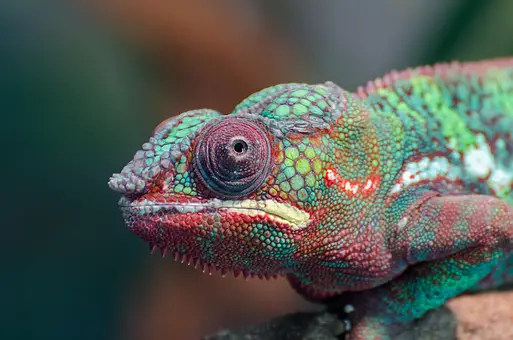Have you ever wondered if chameleons make good pets for beginners? When you think about it, a chameleon is one of the fascinating animals on the planet. So why would you want to own a chameleon as a pet? This post will discuss the pros and cons of owning a chameleon as a beginner. You will learn if chameleons are the best reptiles for beginners as pets and whether or not they are suitable for you.
In this article
The Pros and Cons of a Chameleon as a Pet.
There are many benefits to owning a pet chameleon, but it’s essential to consider several factors before deciding if you want one.
Chameleons can be some of the coolest and cutest pets around. You should definitely give them a try! However, chameleons are tricky to care for as they can be a bit skittish and do not tolerate physical contact well. If you’re a person who prefers to interact with your pets, then you might want to learn their specific requirements before getting one.
We will highlight the critical pros and cons that we believe will better equip you to make an informed decision if chameleons are good pets for beginners.
What Are the Pros of Owning a Chameleon?
Chameleons are peaceful and quiet pets.
The only noise a chameleon makes is the sound of leaves rustling or any item it comes into contact with when moving around.
Pet Chameleons are fun to watch.
Chameleons are remarkable animals, and they’re even more interesting to observe when they change their colour. There is a calm and peaceful quality that comes from watching the chameleon move, which has a calming effect on observers.
Seeing Chameleons’ eyes look all around, their coiled tails grasp tree branches, and their long tongue springing out to capture their prey all make for a thrilling and exciting experience when watching them.
Chameleons require limited attention.
Besides routine maintenance, watering, feeding, and ensuring optimum enclosure temperature, chameleons are happy to be left alone. This makes chameleons good pets for beginners or hobbyists that want hands-off pets.
Chameleons are less messy and produce no smell.
Chameleons are not like cats or dogs because they don’t omit any odour from their bodies. While they can mimic colours, the only scent you should expect to find in your chameleon enclosure is the one left by its previous owners or out of poor enclosure maintenance.
Chameleons have a relatively long lifespan.
Chameleons can live a long time. In fact, some types of chameleons can live to be 10 years old or even older. It is estimated that they live for around 10 years, so you should enjoy your friendship for a long time.
What Are the Cons of Owning a Chameleon?
Chameleons don’t like being held.
Chameleons are fascinating solitary reptiles. They are often hunted because they are a favourite food to many predators and thus tend to camouflage and hide in their environment.
The vast majority of chameleons don’t enjoy being handled. Chameleons are more likely to tolerate being held because they cannot do much about it.
Chameleons are a bit expensive and hard to care for.
The top questions asked by many beginners are; How hard is it to care for a chameleon? And Are chameleons high maintenance?
In summary, the beginning setup cost is around $700 for most people. Additionally, one will expect an annual maintenance cost of about $1,000 that includes electricity and vet care charges.
Chameleons are among the most expensive pets a beginner could ever own, primarily because of the high cost of living in a chameleon cage. Some of the notable items that escalate the cost include;
- Special lighting
- Chameleons require live food
- They require live plants
- It is preferable to use a large enclosure
- Ensuring correct temperature
- Their live food needs to be also taken care of, and
- Extra vigilance on signs of illness.
Chameleons can get sick quickly.
Chameleons are incredibly fascinating creatures. They’re easy to care for, beautiful, and have an almost unlimited variety of colours. One of their problems is that they get sick quickly. If you don’t watch out, they can get diseases you’ve probably never heard of before, like metabolic bone disease and mouth rot.
Most chameleons are healthy and well-adjusted animals, but they are susceptible to various medical problems if not kept in proper conditions. Therefore, the first step towards maintaining good health for your pet chameleon is setting them up in the best possible conditions.
Chameleons eat live bugs.
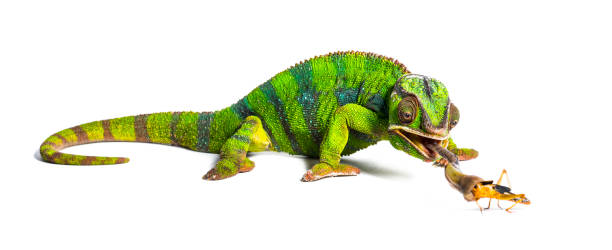
In general, chameleons only eat live insects. Chameleons are not the best choice of pet for those who insects freak out.
Your chameleon only eats live insects. This means that you’ll have to provide a suitable diet for them to eat. You’ll need to be keen on what the insects eat and make sure they eat plenty of vegetables. This is because anything the insects consume will become food for your chameleon.
Female Chameleons lay eggs.
In principle, laying eggs is not a bad thing. However, this means extra care and factors have to be put in place to handle the eggs safely.
Chameleons will typically lay eggs every three to six months. As is the case with all reptiles, chameleons require water, extra food, and plenty of space to lay eggs. In addition, they must be given their daily requirement of calcium as the shell is made up of calcium carbonate. These are additional costs and responsibilities a beginner may not be ready to delve into.
Are Chameleons Good Pets for Beginners?
Is a chameleon a good starter pet?
After reading the above, I believe you now understand whether a chameleon is a good pet for you. Whether you’re looking for the correct type of chameleon for you or just want to know more about what chameleons make the best pets, we will elaborate on these below.
It is not always clear how to judge whether a specific trait is a pro or con. Some people enjoy holding animals while others prefer watching them from a distance. Therefore, the fact that chameleons do not enjoy being held can be both a con and a pro, depending on the person’s preference.
How hard is it to care for a chameleon?
Chameleons are not the easiest pets to handle, but they can still make for a good pet. They can be a fantastic experience even for a beginner and are much less messy than other types of reptiles.
I like to think of chameleons as “cool pets”. They’re a lot of fun to care for, but they’re not meant to be handled. Just like fish, chameleons like only to be seen and not touched.
Chameleons require extra care and maintenance than other reptiles to keep them healthy and happy –Read more here on how to make your chameleon more comfortable. However, these do not make chameleons bad or even difficult pets, but they illuminate who is best suited for chameleons.
One doesn’t just “get” a chameleon. One needs the right temperament, an appropriate attitude, and the proper expectations of what a chameleon is, how it is maintained, and its requirements. Chameleons are very hard to raise if one is unprepared for that challenge!
What Chameleons make the best pets?
Before delving into listing the best chameleons we think are suitable for beginners, we must look at some general factors to be considered. These factors, like ‘How big do chameleons get?’, cut across the different chameleons, and you will be better placed to get a perfect match for a pet.
Should I get male or female chameleons as pets for beginners?
Below are some of the factors to consider;
- Male chameleons can be a bit more aggressive than their female counterparts.
- Adult female chameleons will need extra space in their habitat to bury their eggs.
- In size, male chameleons grow bigger than females.
Should I get a wild-caught or captive-bred chameleons as pets for beginners?
Wild-caught animals are often more aggressive than their domestic counterparts. This is due to factors such as their environment and instincts. On the other hand, captive-bred animals are much easier to handle and pet.
When chameleons are taken from the wild, it’s essential to find a place with proper facilities and personnel for their care. Otherwise, you risk spreading diseases that will be extremely hard to cure. This is an additional and unnecessary hurdle a beginner should avoid.
Below are the advantages of captive-bred chameleons;
- Captive-bred chameleons have shorter acclimation and quarantine times if at all necessary.
- Chameleons bred in captivity show vitality and improved health in general.
- There is a significant reduction of parasites and infections in a captive-bred chameleon.
- Importantly, your breeder will be a critical resource to assist you in addressing and answering any problems you may encounter with your new pet.
What is the best age to buy chameleons as pets for beginners?
When purchasing a chameleon, they best be from three weeks to eight weeks old.
Older chameleons should usually be avoided as they may have been caught in the wild and are not vaccinated or adequately treated. Young chameleons should also be considered a bit risky due to their small size and prone to injury.
Here are the top chameleon types we believe will be the best pets for beginners:
The Panther chameleon
Panther chameleons are natives of the Madagascar coast. Adult females measure between 12 to 14 inches while the male chameleons and larger measuring 16 to 18 inches.
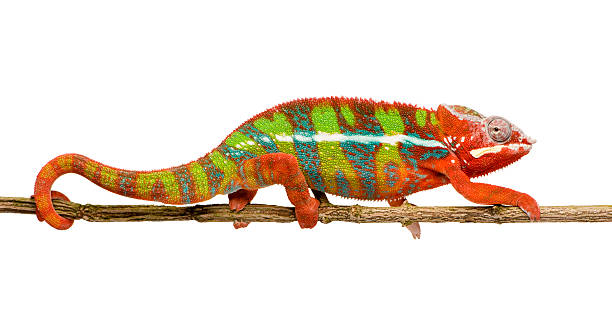
Panthers are the perfect pet for anyone looking to add a little bit of colour to their home or office space. They’re not as demanding as some other types of chameleons, and they’re easy to take care of and relatively hardy.
The panthers are big and slow. Their vast bodies require a massive enclosure that’s at least four feet high, two feet wide, and two feet long.
The panther chameleons are beautiful creatures with a very unusual pattern and colour. They make a favourite for many keepers of exotic pets.
A Panther chameleon costs anywhere from $270 to upwards of $500.
Unfortunately, the average lifespan of a panther is 5 years.
The Veiled Chameleon
The veiled chameleon (Chamaeleo calyptratus) is a giant lizard that lives in the arid lands of Arabia and northern Africa. Adult females measure up to 18 inches while the males and often larger.
Veiled chameleons are not just pretty; they are pretty intelligent!
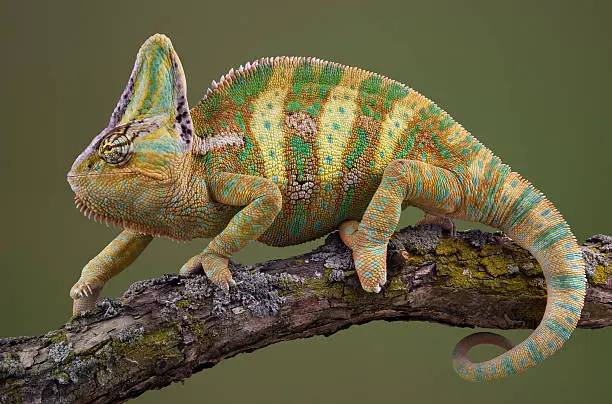
Veiled chameleons have unique features called a casque. The casque (or “casque-chapeau” in French) is a growth on the top of the chameleon’s head. This casque acts as a water collection device allowing the chameleon to drink when water collects and rolls down its head towards the mouth.
The enclosure requirement for the Veiled Chameleon is similar to the Panther chameleon size. It should be at least four feet high, two feet wide, and two feet long. However, bigger is always better.
The veiled chameleons can live for approximately six to eight years on average and are relatively easy to find and inexpensive to buy. On average, Veiled Chameleon cost between $100 and $500.
The Jackson’s Chameleon
In the pet trade, these chameleons are the perfect pet for anyone looking for an exciting challenge! These chameleons have three protruding horns and a docile disposition, making it easy to see why they’re so popular. Their lifespan is better than average, making these an excellent choice for a beginner or expert pet owners.
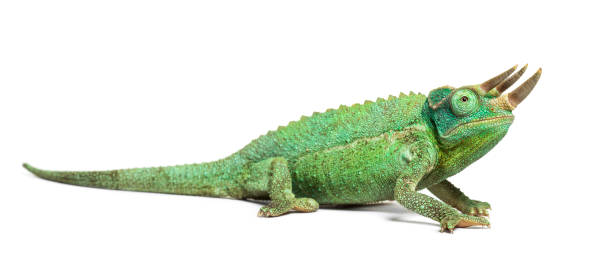
The Jackson’s chameleon is a moderately sized species native of Africa in South- Central Kenya and Northern Tanzania. Adult males grow to about 6 to 15 inches, while females are smaller and grow to about 6 to 10 inches.
The chameleon is a highly diverse species that have been known to come in a wide range of colours. Most are brown when young, but upon maturity, males have bright green colouration that may include varying degrees of blue and yellow.
Jackson’s chameleon can survive in captivity for approximately 10 years and require significantly smaller enclosures. Between 5 and 8 years is the average age they can survive in the wild.
Jackson’s Chameleons cost ranges from $125 to upwards of $180. This is not too expensive in comparison with the other available species.
Is owning a chameleon legal?
Depending on your country of residence, one of the top questions when seeking exotic pets such as Chameleons would likely be; Is owning a chameleon illegal?
Many chameleons are protected species under the CITES (Convention on International Trade in Endangered Species) program.
CITES is a wildlife trade treaty signed in Washington, DC, in March 1973. The United States, Australia, all European countries, and Latin America are part of the Convention on International Trade in Endangered Species of Wild Fauna and Flora (CITES). The CITES organization monitors trade in endangered species and their parts.
A veiled chameleon, for example, is a protected species. This means that it is illegal to take a veiled chameleon from its natural habitat. It is also unlawful to keep them in captivity as they are part of the wildlife protected by law. Many other species of chameleon are also protected species.
Some are not protected and are just kept as pets, while others are illegal to keep as a pet. However, it is okay to own, breed, and sell them with a permit from CITES.
Always check the relevant government departments to ensure you are acquiring and keeping a pet legally.
Conclusion.
So, are chameleons good pets for beginners?
Finding the perfect pet for you and your lifestyle can be a complicated process. If you can invest a little time and research, you will be able to pick the right pet for you and your lifestyle.
Finally, if you are someone who loves learning and research, is okay with not physically interacting with your pet, and are a fan of live bugs, a chameleon will be a perfect choice for you.

